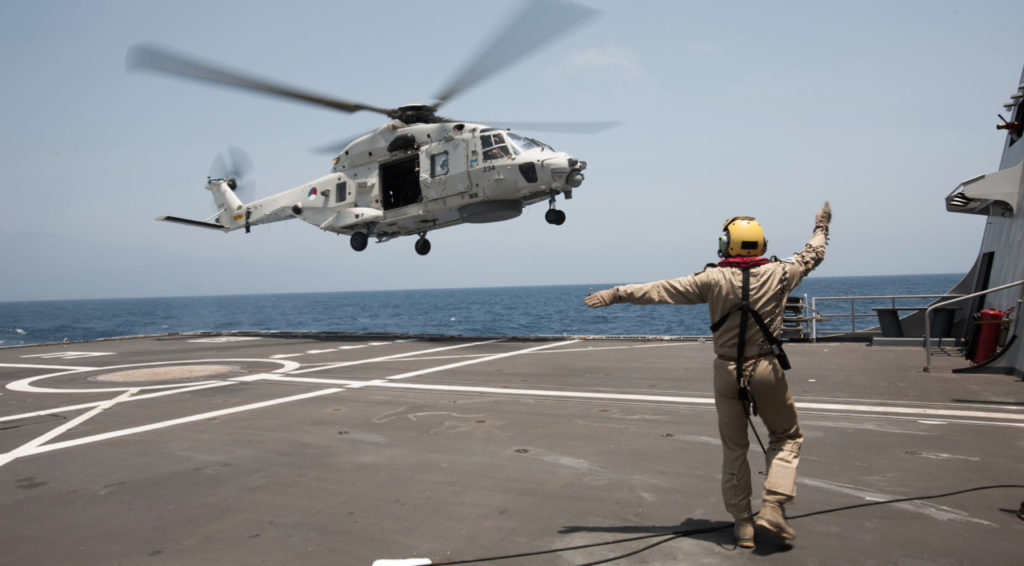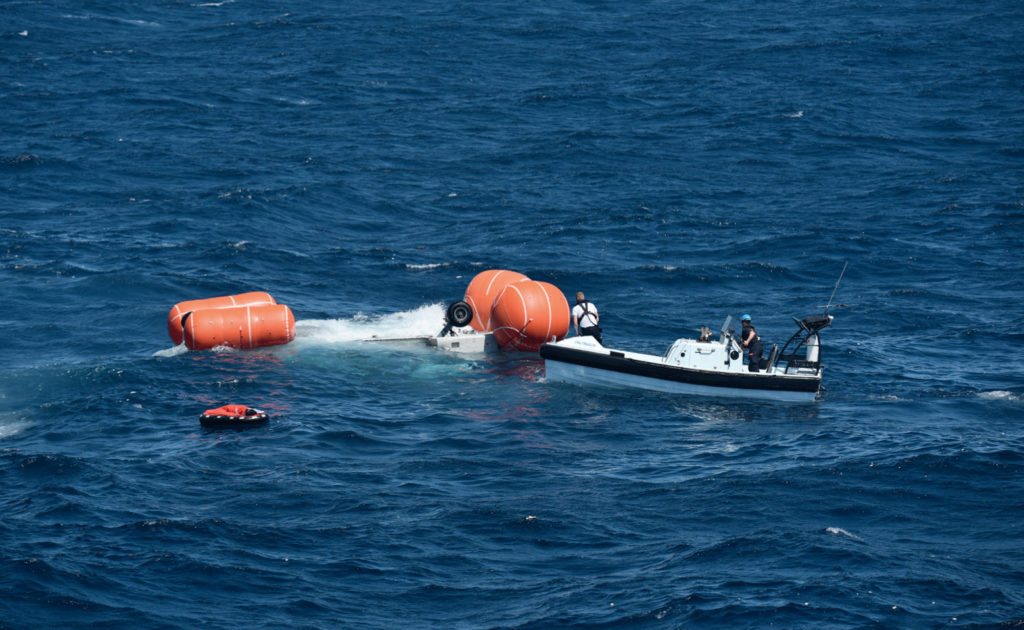The Dutch NH90 that crashed into the Caribbean Sea in July, killing two naval officers, experienced a loss of lift when it turned downwind at a low altitude and was unable to recover before hitting the water.
On July 19, the NH90 with four crew aboard was practicing deck landings with the Royal Netherlands Navy ship Groningen, near Aruba, when it crashed into the sea. Immediately after the accident, the Dutch Safety Board, together with the Defense Security Inspectorate (IVD), launched an investigation. A report detailing the finding of that investigation was published Dec. 9, in Dutch.

Translated using Google, a summary of the report said “the helicopter ran into problems because the aircraft, by making a turn, was at the same speed as the wind. As a result, the device hung still in the air. A lot of extra power is then needed to keep the helicopter in the air.”
The pilot attempted to increase collective power, “but due to the low flying height it was impossible to correct the initiated drop in time. The helicopter quickly lost altitude and hit the water within seconds,” the summary continued.
The full report elaborated: “During the flight, the aircraft entered a situation during the turn to downwind in which the aircraft was stationary with respect to the surrounding air. It was determined that the selected power, given the airspeed at that moment, was not sufficient to keep the helicopter at altitude. As a result, the helicopter slowly lost altitude. At the time of the rapid fall that occurred, the flight altitude was too low for a realistic chance of recovery from the above situation.”

Helicopters generally require more power at lower speeds and a whole lot of power to hover, when forward airspeed is zero. The NH90 specifically needs ever more power to maintain altitude as it slows below 80 knots, according to the report. While “the NH90 had more than sufficient power to hover at height under the circumstances of the incident,” its forward airspeed effectively fell to zero when it turned downwind to return to the ship. Without sufficient power to the main rotor, the aircraft began to descend — slowly at first and then more rapidly, according to the report.
After hitting the water, the helicopter flipped over, though its emergency flotation system intially deployed and kept the fuselage floating during recovery efforts launched by another helicopter and from the Groningen. Two of the four inflatable floats eventually deflated, causing the wreckage to sink.

Both 34-year-old pilot Lt. Christine Martens and 33-year-old tactical coordinator Lt. Erwin Warnies, who were sitting in the cockpit, “were unable to detach themselves from the aircraft in time and drowned,” according to the report. Two occupants in the back of the aircraft were able to free themselves and were pulled from the water by rescuers from the Groningen. Autopsies of both deceased crewmembers showed no life-threatening injuries from the crash itself.
A dive team from the Groningen was able to recover the onboard flight data recorder before the aircraft sank. The recorder “did not reveal any technical deviation,” showed that both engines were operating properly and that the main rotor was spinning normally, according to the report.
All four crew onboard the aircraft were wearing personal floatation devices, but had not been trained in their use, according to the report. The inflatable vests “prevented a quick escape of the backseaters and reduced the chances of survival,” the report concluded.
Warnies was found sitting and stuck in his seat belt, with his life vest inflated. The vests are not self-inflating, so he likely inflated the vest himself.
Martens managed to exit the aircraft, but was found unconscious underwater, entangled in a connecting line to the helicopter.
While providing insight into the causes of the crash, the government’s investigation is also bringing into question the way in which Dutch NH90s are flown and whether its ships are manned with properly trained rescue personnel.
“These questions relate to the education and training of the crew, the choice to fly with one pilot per NH90 helicopter and the choices that have been made about the equipment of the naval ship HNLMS Groningen,” the report said.
“During this exploratory investigation it appeared that crewmembers of HNLMS Groningen tried to save the helicopter crew with maximum effort. Nevertheless, the question remains whether the station ship was sufficiently trained with regard to crew size, composition and role system to be able to carry out such a rescue operation. It is certain that they had insufficient resources for this; so divers were lacking.”










Good morning. What I understand from this report is that the crew entered what we call a vortex ring effect. The only way to escape from a fatal crash in this situation is lower the collective, put the nose down and escape from the vortex by gaining speed in a dive underneath before returning to stabilised flight. This procedure requires a lot of height or altitude to succeed. God bless the crew, Rest in peace
In your analysis/summary you forgot to mention one important thing. The summary of the Dutch report mentions that after seven successful deck landings, during the eighth flight of the day, they had the intention to take pictures of the vessel. And this is where all went pear-shaped. So this accident is not really about downwind turns and how to deal with a ‘powered required exceeds power available’ situation. Rather it is about the risk associated with photo flights where pilots get distracted and stop flying the aircraft.